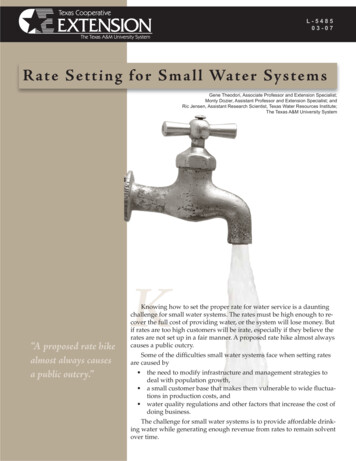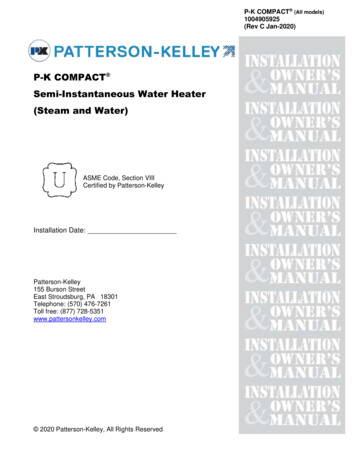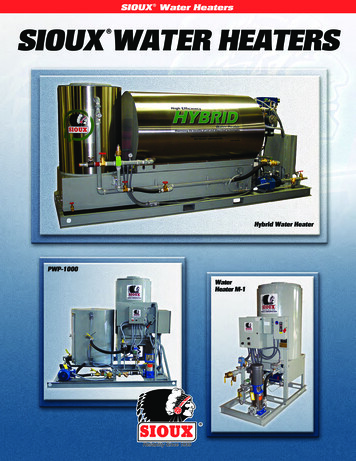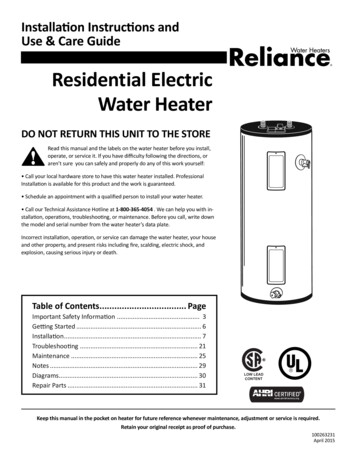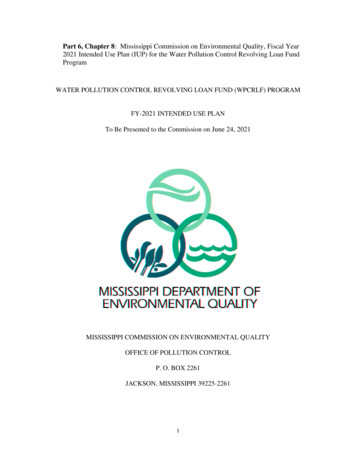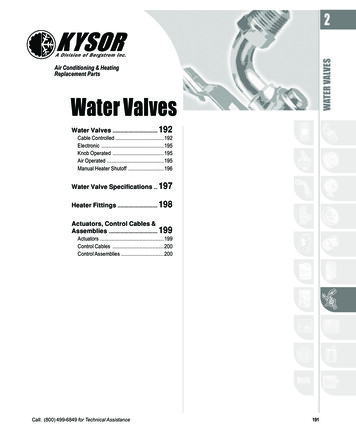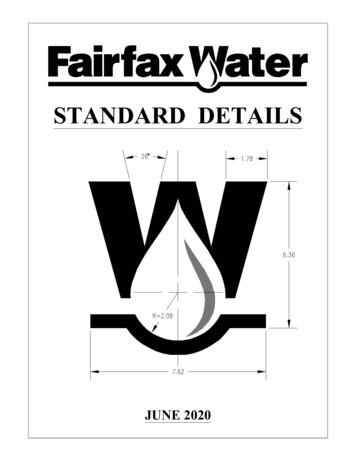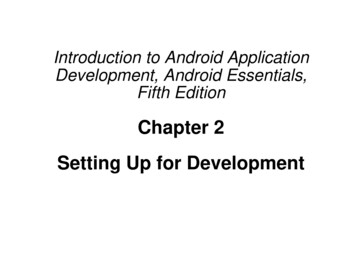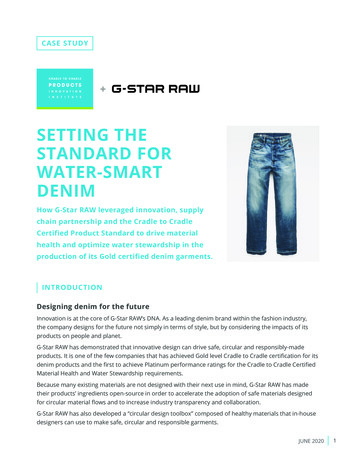
Transcription
CASE STUDYSETTING THESTANDARD FORWATER-SMARTDENIMHow G-Star RAW leveraged innovation, supplychain partnership and the Cradle to CradleCertified Product Standard to drive materialhealth and optimize water stewardship in theproduction of its Gold certified denim garments.INTRODUCTIONDesigning denim for the futureInnovation is at the core of G-Star RAW’s DNA. As a leading denim brand within the fashion industry,the company designs for the future not simply in terms of style, but by considering the impacts of itsproducts on people and planet.G-Star RAW has demonstrated that innovative design can drive safe, circular and responsibly-madeproducts. It is one of the few companies that has achieved Gold level Cradle to Cradle certification for itsdenim products and the first to achieve Platinum performance ratings for the Cradle to Cradle CertifiedMaterial Health and Water Stewardship requirements.Because many existing materials are not designed with their next use in mind, G-Star RAW has madetheir products’ ingredients open-source in order to accelerate the adoption of safe materials designedfor circular material flows and to increase industry transparency and collaboration.G-Star RAW has also developed a “circular design toolbox” composed of healthy materials that in-housedesigners can use to make safe, circular and responsible garments.JUNE 20201
Driving InnovationCradle to Cradle certification has served as a framework to drive innovation across G-Star RAW’svalue chain of designers, suppliers and manufacturers, and to empower its customers to make moreresponsible choices.In 2016, G-Star RAW began partnering with German indigo producer DyStar, Pakistan-based denim millArtistic Milliners, and third-party Cradle to Cradle assessor Eco Intelligent Growth (EIG), to formulate andlaunch the Kir Denim O fabric (Artistic Milliners’ Dylan fabric), the world’s first Gold-level Cradle to Cradlecertified denim fabric. The fabric was certified in 2017 and launched into the market in 2018. Since then,G-Star RAW has designed five more certified fabrics with Artistic Milliners, including the world’s firstCradle to Cradle Certified Gold denim stretch fabric launched in 2019.By January 2020, G-Star RAW achieved Gold level Cradle to Cradle certification for a full range of finishedgarments manufactured by Saitex in Dong Nai, Vietnam using Artistic Milliners’ certified denim fabrics.By leveraging innovative design, the strength of its partnerships and the rigor of the Cradle to Cradleproduct standard, G-Star RAW has demonstrated how material health and water stewardship can beoptimized across the supply chain, even in water-stressed regions like Pakistan and Vietnam.JUNE 20202
THE CASE FOR CHANGE: DENIM’S WATER FOOTPRINTWith an economic share of 1.5 trillion USD1, fashion is one of the world’s largest consumer industries.2Driven by accelerating demand, manufacturing volume has more than doubled since 20023. With aprojected 8.5 billion people requiring clothing by 20304, the rate of consumption will continue to climb.As a result, the industry is also responsible for employing more than 300 million people along the valuechain, generating the equivalent of one garbage truck full of waste every second and producing up to10% of the world’s carbon emissions5.Fashion is also the world’s second-largest consumer of water, and denim garments arethe single-most water6 intensive items to produce. From cotton production to wear, asingle pair of traditionally manufactured jeans can consume as many as 7,000 litres ofwater throughout its life cycle7.While cotton cultivation is responsible for a significant portion of denim’s water consumption,the manufacturing and use stages of a denim garment’s life cycle also represent significant waterconsumption, with dyeing, washing and special visual effects and washing during the use phase amongthe chief factors8.Denim’s water impact is not limited to the volume of water consumed. Final stage manufacturing oftenuses halogenated organic compounds (chlorine), heavy metals (cadmium, chromium, cobalt, tin) andsurfactants with high aquatic toxicity. Such chemicals pose risk to both human and environmentalhealth via their impact on water quality and safety. Left untreated, the chemicals become effluentsreleased into the biosphere during final stage manufacturing and through the consumer stage of thelife cycle, namely during home washing. Similarly, garment care labels are often made of polyester, apetroleum-based product with direct impacts on water bodies, along with carcinogenic materials suchas antimony trioxide.These factors demonstrate the importance of optimizing the material health of fabrics and garments,as well as introducing water-smart dyeing and finishing processes that reduce water consumption.O’Connell, Liam. 21 January 2020. Global Apparel Market Statistics and Facts. Viewed 12 May 2020. t-worldwide1Knight, Lizzie. 7 January 2020. Sustainability within the Fashion Industry Faces an Uphill Climb. ABC News. Viewed 12 May 1196692Ellen MacArthur Foundation. (2017) A New Textiles Economy: Redesigning Fashion’s Future. Summary of Findings: The case forrethinking the global textiles system, starting with clothing, pg 18. Viewed 12 May 2020. wnloads/A-New-Textiles-Economy Full-Report Updated 1-12-17.pdf3Global Fashion Agenda & Boston Consulting Group. (2017) Pulse of the Fashion Industry, The Case for Change is Indisputable,pg 8. Viewed 12 May 2020. 2017/05/Pulse-of-the-Fashion-Industry 2017.pdf4Ellen MacArthur Foundation. (2017) A New Textiles Economy: Redesigning Fashion’s Future. Summary of Findings: The case forrethinking the global textiles system, starting with clothing, pg 18. Viewed 12 May 2020. wnloads/A-New-Textiles-Economy Full-Report Updated 1-12-17.pdf5Knight, Lizzie. 7 January 2020. Sustainability within the Fashion Industry Faces an Uphill Climb. ABC News. Viewed 12 May 11966967 Preuss, Simone, 15 Sustainability Efforts of the Denim Industry. 30 December, 2019. Accessed 9 May 2019123046800.Omotoso, Moni. 1 June 2018. Why Denim Manufacturing Impacts the Environment. Viewed 10 May 2020. nim-manufacturing-impacts-the-environment/8JUNE 20203
HOW THE CRADLE TO CRADLE CERTIFIED PRODUCT STANDARD DRIVESWATER STEWARDSHIPCradle to Cradle Certified is the world’s leading science-based standard for designing and makingproducts that maximize health and wellbeing for people and the planet.To achieve certification, companies engage with an independent Cradle to Cradle Certified AssessmentBody9 to assess, optimize and verify a product’s performance according to the standard’s five criticalsustainability categories: Material Health, Material Reuse, Renewable Energy and Climate, WaterStewardship and Social Fairness.A product is assigned an achievement level (Basic, Bronze, Silver, Gold, Platinum) for its performance ineach quality category. The product then receives Cradle to Cradle certification based upon the lowestquality category performance. [For example, a product that receives a Platinum performance rating infour categories and a Gold performance rating in one category will receive Cradle to Cradle certificationat the Gold level]. Certification must be renewed every two years on the basis of demonstratedcontinuous improvement across one or more categories.Because material health and water quality are intrinsically linked, the Cradle to Cradle CertifiedProduct Standard is uniquely positioned to unlock a ripple effect for companies committed to usingsafe chemicals in their products and manufacturing processes. The higher a product’s Material Healthperformance, the greater the assurance that the product poses no risk to water quality, or to thehealth of aquatic ecosystems and marine environments. In turn, the standard’s Water Stewardshiprequirements also provide companies with a qualitative and quantitative framework to evaluate aproduct’s effect on water consumption and release.Cradle to Cradle Certified Material Health RequirementsThe ultimate goal of the Cradle to Cradle Certified Material Health requirements is thatall products are manufactured using only those materials that have been assessed andoptimized for human and environmental health and do not contain any highly problematicsubstances (known as X assessed substances), or Grey assessed substances, which cannot befully assessed due to lack of toxicity or formulation data. As the percentage of assessed andoptimized materials in a product increases, the safety of the finished product increases.At the Platinum level, 100% of the product’s materials and all process chemistry that comesinto contact with the product have been verified as compatible with human and environmentalhealth. This means that each chemical in the product, and in the process chemistry used tomake the product, has been assessed positively against a comprehensive set of toxicity criteriaranging from carcinogenicity to aquatic toxicity.Cradle to Cradle Certified Water Stewardship RequirementsThe Cradle to Cradle Certified Water Stewardship requirements recognize that fresh water isa scarce and valuable resource. The requirements aim to ensure that product manufacturersare evaluated against their understanding of (and responsibility for) water withdrawals,9In this case, G-Star RAW engaged with Cradle to Cradle Certified assessor Eco Intelligent Growth (EIG)JUNE 20204
consumption, and releases within their local ecology, and that they are rewarded forinnovation in the areas of conservation and quality of discharge. The requirements providea qualitative and quantitative measure of water usage and water effluent related directly tothe manufacture of the certified product.At the Gold level, chemicals that enter effluent as a result of product final manufacturinghave been optimized for material health. At the Platinum level, either water is not used, aclosed-loop system is in place (so water is used but not released), or any water releasedis of drinking water quality. In addition, all supply chain water issues have been identified,investigated and managed.APPLYING THE STANDARD: OPTIMIZING WATER STEWARDSHIP ACROSSTHE SUPPLY CHAINRecognizing that the key to transforming denim’s water impacts begins with material health, G-Star RAWsaw an opportunity to leverage the Platinum Material Health rating of its Cradle to Cradle Gold certifiedKir Denim O fabric by producing a range of finished garments certified at the Gold level.Using the Cradle to Cradle Certified Platinum level Water Stewardship requirements as a blueprint,G-Star RAW partnered with Artistic Milliners to find and develop safer chemistries for fabric dyeing, andlater with Vietnam-based Saitex to assess and optimize washes and finishes for the final garment. Thisresulted in a product and process chemistry that posed no risk to humans or the environment, includingaquatic environments.Optimizing Material Health1. Fabric: Safer Dyes & Fixing AgentsArtistic Milliners and DyStar co-developed the Crystal Clear indigo dyeing process to supportG-Star’s quest for a denim fabric that met Cradle to Cradle Certified Platinum level MaterialHealth performance standards. Crystal Clear uses a salt-free organic fixing agent with fewerchemicals and a hydro-free dye process that results in clean, recyclable water effluent with nosalt by-products. Its heat-free fixing process uses less energy and because Crystal Clear usesa pre-reduced liquid indigo with no additional water or salt, it allows up to 100 percent of theindigo to be recovered10.2. Garment: Safer Finishing ChemicalsFinishing chemicals used during final stage garment manufacturing can enter the biosphere aseffluent or during home washing at the consumer-use stage. Examples of potential pollutantsinclude halogenated organic compounds (chlorine), heavy metals (cadmium, chromium,cobalt, tin), and surfactants with high aquatic toxicity. To achieve platinum level material healthrequirements for its certified garments, G-Star RAW worked with Saitex to ensure that 100%of the washing chemicals used during the finishing stage were optimized to pose no risk tohumans or to the environment, including marine life.Velasquez, Angela. 6 December 2017. “Artistic Milliners Wants to Set a New Standard for Indigo Dyeing”, Sourcing Journal.Viewed 14 May 2020. istic-milliners-dystar-95797/10JUNE 20205
K eyOutcomes Safe Materials: Dyes and fixing agents used in fabric production, as well as finishingchemicals used in garment manufacturing, are verified for human and environmental safetyat the Platinum level based on the Cradle to Cradle Certified Material Health methodology. IncreasedWater Quality: Optimization of chemicals at the fabric and garment level assuresthere is no risk of water quality issues in the event of release to the environment, or in thewastewater sludge generated during final manufacturing and channeled by Saitex to be madeinto construction bricks or agricultural fertiliser (see below).Maximizing Water Stewardship: Fabric to Final Garment1. Sourcing: Organic CottonG-Star RAW and Artistic Milliners sourced GOTS certified organic cotton for the Cradle toCradle Certified Gold denim fabric that was used to make the finished garments.K ey Outcome ReducedWater Consumption: GOTS Certified cotton reduces upstream waterconsumption by as much as 60 percent compared to conventional cotton.112. Production: Water Smart ProcessesThe Cradle to Cradle Certified Gold denim fabric used in the range of G-Star RAW garments isproduced by Artistic Milliners in Pakistan, a severely water-stressed region. Artistic Milliners’11Thinkstep (June 2019) Life Cycle Assessment of Cotton Cultivation Systems. Accessed 18 May 2020. 4332environmentallcareportjune19.pdfJUNE 20206
production processes were assessed for propermanagement of its on-site water treatment facilityand the use of minimal process water. In order toachieve a Platinum Material Health rating for the fullgarments, G-Star RAW enlisted Saitex for the finalstage manufacturing. Known for innovative waterstewardship in a notably water-scarce region, Saitex isa LEED-certified facility that recycles 98%12 of its ownprocess water through a closed-loop water recyclingprocess and is powered by solar and fossil fuel-freeenergy sources.13 (The company also uses an air-dryingprocess for finishing the garments for an energy savingsof up to 85%).During final-stage manufacturing, wastewater from thedenim garments produces a sludge by-product whichoccurs for all wastewater treatment plants. Sludgeis often incinerated or sent to landfill. If the sludgecontains toxic materials from the process chemicalswashed out of the garment, these toxins will also beincinerated or landfilled, where they can leach into soil,water and stormwater run-off.Making a Better Label:Garment care labels areoften made with polyester,a petroleum-based productthat can be a significantcontributor to microfibrepollution in the world’soceans because they cancontain carcinogenic materialssuch as antimony trioxidealong with organohalogens,polyester labels and the inksthey require can have directimpacts on water bodies and/or can pose risk to humanhealth. For the certifiedgarments, G-Star RAW usedan alternative GOTS certifiedorganic cotton label speciallymade for this project toensure a high-quality andsafe final product for peopleand the environment.Because 100% of the finishing chemicals used in thefinal G-Star RAW garments had been optimized andverified according to Cradle to Cradle Certified Platinumlevel Material Health requirements, Saitex’s wastewatersludge is safe for use as a component in bricks forthe construction of affordable housing.14 The sludge can also be used as a component infertiliser for use in Saitex’s on-site hydroponic farming system, which provides food for Saitexemployees, charitable organisations and communities.15 K eyOutcomes SupplyChain Water Management: All supply chain water issues are investigatedand managed. ClosedLoop Water: Zero water is discharged into the environment because 98%16 of thewater used to produce G-Star RAW’s garments is recycled by a wastewater treatment facilityat the Saitex plant in Dong-Nai, Vietnam.12, 16Per http://www.sai-tex.com/environment/, 2% of the process water is lost to evaporation.13, ai-tex.com/saitex-farms/JUNE 20207
I ndustrial Symbiosis: Platinum-level Material Health performance ensured that 100% of allchemicals in the garments are considered risk-free for humans and the environment. As aresult, the remaining sludge from wastewater treatment at the final manufacturing stage issafe for use in construction bricks and agricultural fertiliser. ReducedWater Stress: Saitex is located within proximity of the Dong Nai watershed whichis served by the Dong Nai River and is at high risk of water stress.17 This risk is primarilydue to the high level of industry and agriculture in the area. Retaining process water withina closed-loop helps to alleviate demand on the Dong Nai River and reduces the need forextraction from the natural environment.CONCLUSIONAs one of the few companies to achieve Gold level Cradle to Cradle certification for its denim productsand the first to achieve Platinum performance ratings for Material Health and Water Stewardshiprequirements, G-Star RAW has set the standard for designing water-smart denim. By leveraginginnovative design and technology to meet the rigor of Cradle to Cradle certification, G-Star RAW andits supply chain partners Artistic Milliners and Saitex have: Optimized all chemicals in their denim fabrics and garments for human and water safety. Increased water quality across the production cycle, from sourcing to final stage. Reduced water consumption from sourcing to final stage, alleviating water stress in highrisk regions like Pakistan and Dong-Nai, Vietnam.17WRI, Aqueduct Water Risk Atlas, accessed 21 May 2020. sk-atlas/#/?advanced false&basemap hydro&geoStore 05aa3014263d062166a206c16cf39fa7&indicator w awr def totcat&lat 11.068630508610058&lng 78.60314447499997&mapMode analysis&month 1&opacity 0.5&ponderation DEF&predefined false&projection absolute&scenario optimistic&scope baseline&timeScale annual&year baseline&zoom 4JUNE 20208
About the Cradle to Cradle Products Innovation InstituteThe Cradle to Cradle Products Innovation Institute is dedicated to powering innovation for the circular economythrough products that have a positive impact on people and planet.Through the Cradle to Cradle Certified Products Program, the Institute sets the global standard for productsthat are safe, circular and made responsibly. Cradle to Cradle Certified is used by future-focused designers,brands, retailers and manufacturers across the value chain to innovate and optimize materials and productsaccording to the world’s most advanced science-based measures for material health, product circularity,renewable energy and climate, water and soil stewardship, and social fairness.The Institute also powers the global shift to a circular economy through partnerships and collaborative initiativesthat equip businesses, governments and other stakeholders with the technical solutions and knowledge theyneed to innovate the way products are designed and made.The Institute is headquartered in Oakland, California and Amsterdam, the Netherlands with offices inWashington DC. For more information, follow @c2ccertified or visit c2ccertified.org.About G-Star RAWFounded in 1989, G-Star RAW’s unrelenting passion for denim has driven the brand to take craftsmanship tothe next level. “Hardcore Denim” is the philosophy that pushes the brand to invent and explore – down to thesmallest detail. With this dedication to quality and progress, the brand represents the forefront of the denimindustry, producing pioneering styles and challenging industry standards. Innovation and sustainability are at thecore of the G-Star DNA and the brand is committed to lead by example and develop sustainable solutions for thefuture of fashion. Visit g-star.com or download the G-Star RAW app from the App store or Google Play.About Eco Intelligent GrowthEco Intelligent Growth (EIG), a circular economy consultancy based on Cradle to Cradle principles, envisions aworld where business regenerates ecosystems and society. The group has been helping companies to transitiontowards innovative circular business models since 2005, focusing primarily on the built environment, fashion,and packaging. ecointelligentgrowth.netAbout Artistic MillinersFounded in 1949, Artistic Milliners has since expanded to become a fully vertically integrated textile set-up.Its aim is to provide high-end customers with premium quality denim fabrics and garments. Since its inception,the company has been a front-runner in the global textile industry, spearheading denim innovationand sustainability.To reach this position, it continually pushes the boundaries of what a pair of jeans can be. Artistic Milliners takesa holistic approach towards sustainability and has received LEED Platinum certification by US Green BuildingCouncil for its Echo-Tech Unit recently. Artistic Milliners today employs about 16,000 people with representativeoffices across the globe. ArtisticMilliners.comAbout SaitexSAITEX is a privately owned manufacturing operation specializing in premium denim and over-dyed products,with a capacity of over 6 million garments per year. The group is a leader in sustainable manufacturing practices.Saitex’s main facilities are in Vietnam, with facilities soon to be opened in the USA and Europe.Saitex is committed to being conscious of social responsibility as a professional organization in providingsolutions that bring together sustainable natural and green building environments. sai-tex.comJUNE 20209
Cradle to Cradle Certified Water Stewardship Requirements. The Cradle to Cradle Certified Water Stewardship requirements recognize that fresh water is a scarce and valuable resource. The requirements aim to ensure that product manufacturers . are evaluated against their under
